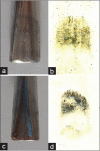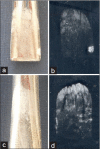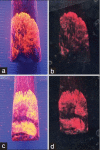Experimental model of developing and analysis of lip prints in atypical surface: A metallic straw (bombilla)
- PMID: 25125921
- PMCID: PMC4130015
- DOI: 10.4103/0975-1475.132543
Experimental model of developing and analysis of lip prints in atypical surface: A metallic straw (bombilla)
Abstract
Background: The interaction between the offender and the victim produces visible or latent prints on objects and utensils. The study of lip prints has reportedly stayed away from the basic cinematic concept of the lip-to-surface relationship.
Materials and methods: Three regular powders were used to reveal the latent lip prints on a typical metallic straw called bombilla, and the revealed prints were photographed, preserved, and analyzed.
Results: Better definition was observed in the lower lip print, and nine anatomical patterns were identified, but a higher definition of wrinkles was observed with indestructible white powder.
Conclusion: Knowledge of labial dynamics, the real value of the processed surfaces, and the need for testing in field conditions are discussed.
Keywords: Cheiloscopy; criminalistics; forensic odontology.
Conflict of interest statement
Figures






References
-
- Godwin M. Death by Detail: A Multivariate Model of U.S. Serial Murderers' Crime Scene Actions. In: Godwin GM, editor. Criminal Psychology and Forensic Technology. A collaborative approach to effective profiling. Boca Raton: CRC Press; 2001. pp. 145–6.
-
- Miethe TD, Drass KA. Exploring the social context of instrumental and expressive homicides: An application of qualitative comparative analysis. In: Godwin GM, editor. Criminal Psychology and Forensic Technology. A collaborative approach to effective profiling. Boca Raton: CRC Press; 2001. pp. 125–6.
-
- Houck MM. Modern methods of solving crime. Westport, USA: Praeger Publishers; 2007. Forensic Science; pp. 34–5.
-
- Green EJ, Booth CE, Biderman MD. Cluster analysis of burglar's modus operandi (M/O) In: Godwin GM, editor. Criminal Psychology and Forensic Technology. Boca Raton: CRC Press; 2001. p. 173.
-
- López-Palafox J. Aplicaciones ignoradas en Odontología forense. Interés de la Queiloscopía en la averiguación de delitos (1st Part) Maxillaris. 2001:52–9.
LinkOut - more resources
Full Text Sources
Other Literature Sources
